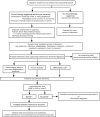Autoimmune dementia: clinical course and predictors of immunotherapy response
- PMID: 20884824
- PMCID: PMC2947960
- DOI: 10.4065/mcp.2010.0326
Autoimmune dementia: clinical course and predictors of immunotherapy response
Abstract
Objective: To define the diagnostic characteristics and predictors of treatment response in patients with suspected autoimmune dementia.
Patients and methods: Between January 1, 2002, and January 1, 2009, 72 consecutive patients received immunotherapy for suspected autoimmune dementia. Their baseline clinical, radiologic, and serologic characteristics were reviewed and compared between patients who were responsive to immunotherapy and those who were not. Patients were classified as responders if the treating physician had reported improvement after immunotherapy (documented in 80% by the Kokmen Short Test of Mental Status, neuropsychological testing, or both).
Results: Initial immunotherapeutic regimens included methylprednisolone in 56 patients (78%), prednisone in 12 patients (17%), dexamethasone in 2 patients (3%), intravenous immune globulin in 1 patient (1%), and plasma exchange in 1 patient (1%). Forty-six patients (64%) improved, most in the first week of treatment. Thirty-five percent of these immunotherapy responders were initially diagnosed as having a neurodegenerative or prion disorder. Pretreatment and posttreatment neuropsychological score comparisons revealed improvement in almost all cognitive domains, most notably learning and memory. Radiologic or electroencephalographic improvements were reported in 22 (56%) of 39 patients. Immunotherapy responsiveness was predicted by a subacute onset (P<.001), fluctuating course (P<.001), tremor (P=.007), shorter delay to treatment (P=.005), seropositivity for a cation channel complex autoantibody (P=.01; neuronal voltage-gated potassium channel more than calcium channel or neuronal acetylcholine receptor), and elevated cerebrospinal fluid protein (>100 mg/dL) or pleocytosis (P=.02). Of 26 immunotherapy-responsive patients followed up for more than 1 year, 20 (77%) relapsed after discontinuing immunotherapy.
Conclusion: Identification of clinical and serologic clues to an autoimmune dementia allows early initiation of immunotherapy, and maintenance if needed, thus favoring an optimal outcome.
Figures






Comment in
-
Autoimmune encephalopathy.Mayo Clin Proc. 2010 Oct;85(10):878-80. doi: 10.4065/mcp.2010.0536. Mayo Clin Proc. 2010. PMID: 20884823 Free PMC article. No abstract available.
References
-
- McKeon A, Lennon VA, Pittock SJ. Immunotherapy-responsive dementias and encephalopathies. Continuum Lifelong Learning Neurol. 2010;16(2):80-101 - PubMed
-
- Castillo P, Woodruff B, Caselli R, et al. Steroid-responsive encephalopathy associated with autoimmune thyroiditis. Arch Neurol. 2006;63(2):197-202 - PubMed
-
- McKeon A, Marnane M, O'Connell M, Stack JP, Kelly PJ, Lynch T. Potassium channel antibody associated encephalopathy presenting with a frontotemporal dementia like syndrome. Arch Neurol. 2007;64(10):1528-1530 - PubMed
-
- Brain L, Jellinek EH, Ball K. Hashimoto's disease and encephalopathy. Lancet. 1966;2(7462):512-514 - PubMed

